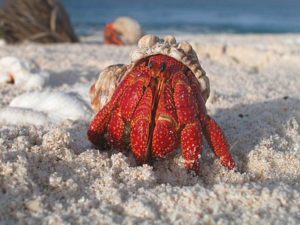I’m a university scientist reaching the end of my career, and recently calculated that I’ve had 115 co-authors on research papers over a 45-year period. Clearly partnering with students and colleagues was a signature element of my research style, but my first experience collaborating was not auspicious, almost destroying a friendship and derailing my career before it really got started.
I was living and working in Woods Hole, Massachusetts in 1973 after graduating from Boston University with a B.Sc. degree in which my performance was considerably less than stellar. The “Hole,” as we called it, was home to the renowned Marine Biology Laboratory (MBL) and the Woods Hole Oceanographic Institution (WHOI), both sources of the short-term research jobs that paid my bills for the next couple of years.
I worked as a research assistant investigating chemical orientation in lobsters, and then landed a summer job for the nearby U.S. Department of Agriculture Gypsy Moth Laboratory, evaluating the use of pheromones to confuse gypsy moths, a serious forest pest. I also had an opportunity to work with a professor in Mexico for two months who was studying wasp social behavior at various latitudes. I filled the in-between times with a few weeks of warehouse work here and there, and a three-week stint as a substitute teacher for high school biology classes.
Two years of this insecure work in varied underling capacities convinced me that I needed to go back to school if I was to ever rise above being someone else’s assistant. I decided to pursue a Masters degree in marine biology, and enrolled in the Boston University Marine Program, based in Woods Hole.
I soon was focusing in on a thesis topic, stimulated by conversations with a postdoctoral fellow at WHOI, Stu, to consider hermit crabs. Stu was loquacious, with an excellent moustache, a productive seaweed-fertilized garden and a young family that was exceedingly generous in inviting me over for meals.
We talked often about science, and one day he pointed out a research opportunity we could collaborate on, probing whether hermit crabs could recognize each other as individuals. This was a hot topic at the time, inhabiting the border between animal behaviour and psychology. Many researchers were convinced that even lowly invertebrates could distinguish one individual from another, a remarkable cognitive feat if true.
Stu and I designed an experiment to test whether hermit crabs recognized each other individually, or just recognized the general dominance state of the other crabs they encountered. We agreed that this would make an excellent thesis topic for me, and thought up a clever study in which we allowed crabs in small dishes to establish dominance orders, then switched individuals of equal dominance states.
We reasoned that switching crabs of the same rank would heighten aggressive behaviors in the dishes if the crabs recognized each other as individuals, but there would be no increase in aggression if they only recognized their place in the hermit crab pecking order.
Very excited, I got to work, collecting crabs in the field and spending many long days and late nights in the laboratory recording their behaviours. I forgot just about everything else, including Stu, in my fervor to get some results. Night after night I worked late, observing the crabs and recording their interactions, building up an array of data that would definitively prove or disprove our hypothesis.
One night my housemate and fellow student Mary, also a good friend of Stu, came in to the lab. She unloaded a diatribe filled with words my young daughter used to politely refer to as “swears.” Mary roundly and colorfully roasted me for how I had taken a fine collaboration and run it into the ground, cutting Stu completely out of the process.
I was devastated, seeing immediately that she was right; I hadn’t talked with Stu in weeks. While I had no evil intention, I had been carried away by enthusiasm to make the project mine, not ours, possibly destroying not only a professional relationship but a good friendship as well.
I went to see Stu the next morning, apologized profusely, and insisted on dumping out the crabs and finding some other topic for my thesis. Stu, wiser and more experienced than I, replied that the nuclear option wasn’t necessary, he just wanted me to include him in my enthusiasm, and bounce ideas about the project back and forth.
Considerably chastened but now wiser, I completed the research, sharing the results and my excitement with Stu, who had much to contribute in interpreting and analyzing what we were finding. We did eventually publish a paper in Animal Behavior together, “Dominance and effects of strange conspecifics on aggressive interactions in the hermit crab Pagurus longicarpus (Say),” indicating that hermit crabs recognized dominance but not individuality.
More significant than the publication, I had learned a valuable lesson. Collaboration is hard. There is no proper balance between individual achievement and the communal good, only choices we make as to where to position ourselves on that spectrum. I had fully intended the project to be collaborative, yet due to over-enthusiasm more than selfishness I found myself on the individualistic end of that continuum.
Perhaps it was that early experience that attracted me to the idea of collaboration, but I did move on from hermit crabs to spend the rest of my scientific career studying bees, particularly honeybees. They inhabit the most collaborative of societies, with colonies whose members are guided more by communal goals than solitary pursuits.
For me the satisfaction of collaboration has been much richer and deeper than any individual achievement, the relationships I built through working with others more meaningful than any personal accomplishment.
I’m forever grateful to hermit crabs, and then to bees, the vehicles for teaching me that “ours” is a much richer word than “mine.”
